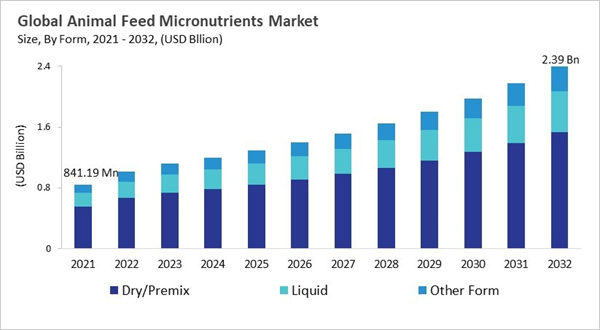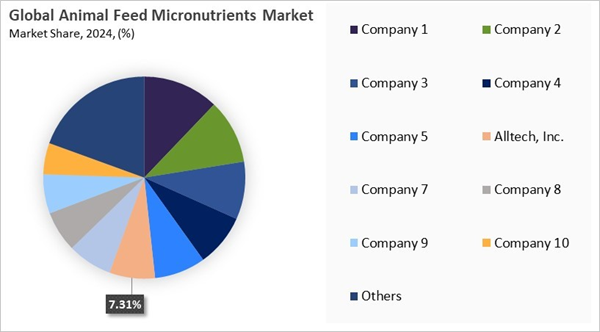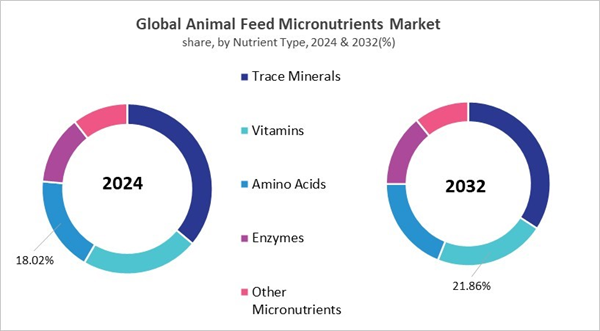Key Highlights:
- The Asia-Pacific market dominated Global Animal Feed Micronutrients Market in 2024, accounting for a 42.00% revenue share in 2024.
- The China market is projected to maintain its leadership in North America, reaching a market size of USD 392.53 million by 2032.
- Among the various Form, the Dry/Premix segment dominated the global market, contributing a revenue share of 65.23% in 2024.
- In terms of Nutrient Type, Trace Minerals segment are expected to lead the global market, with a projected revenue share of 34.17% by 2032.
- Poultry emerged as the leading Livestock in 2024, capturing a 39.22% revenue share, and is projected to retain its dominance during the forecast period.
The animal feed micronutrients market has recently become a highly specialized genre focusing on the important role of minerals and vitamins in health, growth, productivity, and livestock. The market is witnessing a significant shift toward chelated and organic forms with the advancements in environmental safety and bioavailability. This transition is also supported by the regulatory bodies ensuring feed safety and quality. Also, the demand for balanced feed formulations and precision nutrition is rapidly increasing owing to the changing consumer preferences for high-quality animal protein. With the growing livestock production across the globe, micronutrients have also become important in enhancing fertility, disease resistance, and immunity, thereby making them crucial for sustainable animal production.
The animal feed micronutrients market is expanding, supported by elements including the rapid growth in developing nations and the increase in sustainability-focused solutions and precision nutrition. Personalized micronutrient blends are allowing the providers to enhance productivity, feed efficiency, and animal health while reducing waste. Further, the environmental concerns are encouraging the adoption of eco-friendly delivery and formulation systems. The surging demand for animal protein from regions such as Latin America and Asia is resulting in strong growth opportunities. The market is intensively competitive among multinational corporations with global networks and robust R&D, and startups are thriving by cost-effective solutions.
Driving and Restraining Factors
Drivers
- Rising Demand for High-Quality Animal Protein
- Growing Awareness of Animal Health and Immunity
- Industrialization of Livestock Farming
- Regulatory Support and Sustainability Goals
Restraints
- Volatility in Raw Material Prices
- Lack of Awareness and Knowledge Among Farmers
- Regulatory Challenges and Risk of Toxicity
Opportunities
- Innovation in Precision Nutrition and Customized Feed Solutions
- Expansion into Emerging Economies with Rising Livestock Sectors
- Development of Sustainable and Eco-Friendly Micronutrient Solutions
Challenges
- Complexities in Global Supply Chains and Logistics
- Limited Standardization and Scientific Validation Across Markets
- Balancing Cost-Efficiency with Sustainability Expectations
Market Share Analysis
The leading players in the market are competing with diverse innovative offerings to remain competitive in the market. The above illustration shows the percentage of revenue shared by some of the leading companies in the market. The leading players of the market are adopting various strategies in order to cater demand coming from the different industries. The key developmental strategies in the market are Acquisitions, and Partnerships & Collaborations.
COVID-19 Impact Analysis
The COVID-19 pandemic hurt the animal feed micronutrients market because it caused big problems with the supply chain, such as a lack of raw materials, limits on transportation, and higher production costs. Labor shortages and restrictions on movement made it harder for livestock operations to work, which lowered the demand for feed. Market needs went down even more because people ate less meat when restaurants and food services closed. Export restrictions and import delays created price volatility and supply instability. Overall, the pandemic caused fewer sales, problems with running the business, and slower growth in the feed micronutrients sector. Thus, the COVID-19 pandemic had negative impact on the market.Nutrient Type Outlook
Based on Nutrient Type, the market is segmented into Trace Minerals, Vitamins, Amino Acids, Enzymes, and Other Micronutrients. The vitamins segment recorded 22% revenue share in the animal feed micronutrients market in 2024. The vitamins segment is another critical component of the market. Vitamins are essential for regulating metabolic processes, enhancing immune function, and improving overall animal vitality. They contribute to better growth rates, feed efficiency, and disease resistance in livestock.Form Outlook
Based on Form, the market is segmented into Dry/Premix, Liquid, and Other Form. The liquid segment attained 22% revenue share in the animal feed micronutrients market in 2024. The liquid form of animal feed micronutrients is gaining traction as it offers flexibility in application and can be directly added to water or mixed into feed. This form is particularly useful for improving nutrient absorption and providing quick supplementation, especially in intensive livestock farming practices.Regional Outlook
Region-wise, the animal feed micronutrients market is analyzed across North America, Europe, Asia Pacific, and LAMEA. The Asia Pacific segment gained 42% revenue share in the animal feed micronutrients market in 2024. The animal feed micronutrients market is expected to experience growth in the North America and Europe regions. This is due to the factors, including stringent regulatory frameworks, high consumer demand, and advanced livestock farming practices. Market players in these regions are prioritizing sustainability, precision nutrition, and compliance with stringent feed safety regulations. The emphasize on the utilization of eco-friendly and bioavailable micronutrient formulations to improve productivity, welfare, and animal health while reducing environmental impacts like soil mineral accumulation. Both Europe and North America regions are showcasing wide acceptance of innovative feed technologies, led by developed feed companies and research partnerships.In the Asia Pacific and LAMEA regions, the animal feed micronutrients market is predicted to grow at a steady rate. This is driven by the increasing urbanization, rising consumption of animal protein, and growing disposable income. The Asia Pacific region is experiencing rapid growth in the livestock industry, which results in significant demand for micronutrient-rich feed to improve productivity. The LAMEA region is also showcasing profitable market opportunities supported by the rising dairy & meat production, especially in the Middle East and Brazil. The animal feed micronutrients market is growing rapidly, with global as well as regional players investing in localized solutions to cater to regional nutritional requirements.
List of Key Companies Profiled
- Cargill, Incorporated
- Archer Daniels Midland Company
- DSM-Firmenich
- BASF SE
- Nutreco N.V. (SHV Holdings N.V.)
- Alltech, Inc.
- Evonik Industries AG (RAG-Stiftung)
- Kemin Industries, Inc.
- Balchem Corporation
- Zinpro Corporation
Market Report Segmentation
By Form
- Dry/Premix
- Liquid
- Other Form
By Nutrient Type
- Trace Minerals
- Vitamins
- Amino Acids
- Enzymes
- Other Micronutrients
By Livestock
- Poultry
- Ruminants
- Aquaculture
- Equine
- Other Livestock
By Geography
- North America
- US
- Canada
- Mexico
- Rest of North America
- Europe
- Germany
- UK
- France
- Russia
- Spain
- Italy
- Rest of Europe
- Asia Pacific
- China
- Japan
- India
- South Korea
- Australia
- Malaysia
- Rest of Asia Pacific
- LAMEA
- Brazil
- Argentina
- UAE
- Saudi Arabia
- South Africa
- Nigeria
- Rest of LAMEA
Table of Contents
Companies Mentioned
- Cargill, Incorporated
- Archer Daniels Midland Company
- DSM-Firmenich
- BASF SE
- Nutreco N.V. (SHV Holdings N.V.)
- Alltech, Inc.
- Evonik Industries AG (RAG-Stiftung)
- Kemin Industries, Inc.
- Balchem Corporation
- Zinpro Corporation











